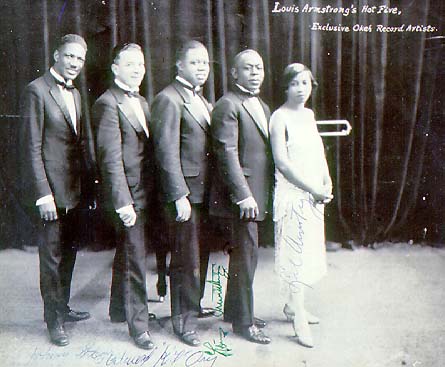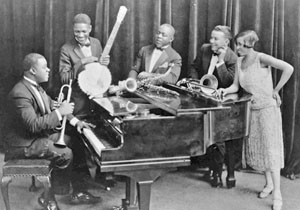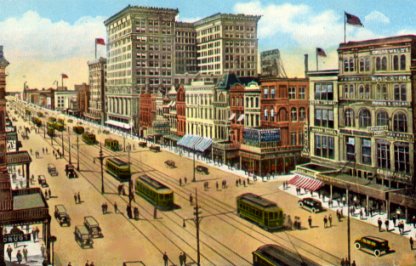This is another in-progress bit of writing in response to things I’ve been reading lately. I’ve found some nicely critical engagments with jazz and jazz study, and am suddenly wishing I was in the US. This isn’t the most coherent of posts, partly because I lost part of it with an inadvertent page refresh. Shit.
I’ve been thinking or wondering about the relationship between Esquire magazine and jazz, partly as a result of my work with the jazz discography (and following Billie Holiday). There were a few concerts in 1944 and 1945 featuring the ‘Esquire All Stars’ – a group of truly big names: Roy Eldridge, Jack Teagarden, Barney Bigard, Coleman Hawkins, Art Tatum, Louis Armstrong, Billie Holiday, Mildred Bailey and others.
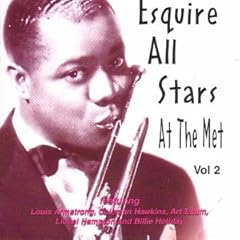
There are some albums released from these concerts, including one interesting one called At the Met, the cover of which is particularly provocative when you consider the issues I raise below.
I’ve just found this in a paper about Miles Davis:
By the 1950s, American had become aware of subtle shifts in social and gender roles. Sociologists and psychiatrists were talking about men trapped in gray flannel suits, the age of conformity, the weakening of the superego, the other-directed person. The concern was that a new postwar economy was creating a society in which people were externally motivated, too well adjusted, too sociable. Scarcely concealed behind the jargon of social science was the fear that it was not women who were changing, but men, who were becoming soft, emotional, and expressive – that is, more like women rather than like the rational and task-oriented patriarchs who had built and protected America. More often than not, such ideas were dressed up as if they were the received wisdom of the ages, but their sources were transparently pop.
Elsewhere, Playboy magazine was wrestling with the same anxieties and assuaging them with a particular kind of male hedonism, promoting the good life for the single man: money, imported cars, circular beds, top-of-the-line stereos, chicks. And like Esquire before it, Playboy championed jazz, as a male music, to be sure, but the music of a certain kind of male, as the couture, decorations, and genderized illustrations of the jazz life in its pages made clear. Then there were the Beats, detested by Playboy, but sharing some of its fantasies by celebrating freedom, male bonding, drugs, art, and the hip lifestyle, one of their inspirations being the nightlife of the black musician (Szwed 183).
This article “The Man” discusses Miles Davis’ masculinity, positioning him in the 1950s as both ‘a man’ and as a jazz musician. There’s lots of talk about ‘masculinity’. We can also draw some conclusions about white, middle class men and their interest in black masculinity as some sort of ‘free’, ‘sensual’ and ‘vibrant’ ideal. Particularly in reference to the Beats.
It’s been interesting reading this article after one about the Newport Jazz Festival, “Hipsters, Bluebloods, Rebels, and Hooligans: the Cultural Politics of the Newport Jazz Festival” by John Gennari. Particularly in reference to this section:
At the Newport Jazz Festival on the fourth of July weekend in 1960, thousands of white youths described by Life magazine as “more interested in cold beer than in hot jazz†spilled from the jazz concerts into Newport’s downtown, attacking policemen, kicking in store windows, and manhandling the town’s residents and visitors. Press reports noted that many of the drunken rioters screamed racial epithets while rampaging through the town. State police used billy clubs and tear gas to stem the riot, then called on the marines for help in restoring order. When the air cleared, over two hundred of the marauders found themselves in local jails, while more than fifty of their victims required medical attention. One witness told the Providence Journal: I’ve experienced fear twice in my life. Once was in combat during World War II; the other was Saturday night in Newport.
Scheduled to end on Sunday night, the festival was ordered shut down on Sunday afternoon by the Newport city council. The last act was a program of blues narrated by Langston Hughes. Anticipating the city council’s action, Hughes penned a set of lyrics on a Western Union sheet. He handed them to Otis Spann, who sang them slowly as the crowd quietly departed.
Among a rash of press reports on the riot, one commentator blamed the allure of Newport, a “resort area which hold[s] a fascination for the square collegian who wants to ball without running the risk of mom and dad stumbling across his prostrate from on somebody’s lawn.†Mordantly noting the contrast between the Newport gentry “in the front row with their Martini shakers†and the youngsters “squatting in the back, their heads between their knees, upchucking their beer,†journalist Murray Kempton wondered, “Was there anything in America at once so fashionable and so squalid?†To many who had embraced Newport as jazz’s City on a Hill, a sterling model of New England Brahmin philanthropy, more disconcerting than the spectacle of loutish yahoos profaning the festival was the rioter’s identity. These were not switchblade-wielding rebels without a cause, nor pothead beatnicks in overalls. These ‘young hooligan herrenvolk of the Eastern seaboard,†as Village Voice jazz critic Robert Reisner dubbed the rioters, were students from the elite colleges, fraternity brothers on a fast track to the corporate boardroom. “You could tell the students from Harvard and Yale,†wagged one man on the street: “They were throwing only imported beer bottles.†(Gennari 127)
I’d previously thought about the Newport Jazz Festival in reference to the film High Society and the documentary film Jazz on a Summer’s Day, both of which suggest class tensions, but in the politest way. Neither references these sorts of middle class men rioting (!). In fact, JOASD is, as Gennari discusses, a more than a little arty, genteel and restrained. Here’s a gratuitous clip to illustrate:
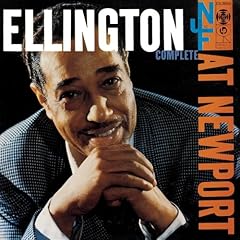 For many dancers Newport is significant for the albums recorded there by Count Basie and Duke Ellington. Gannari discusses the racial tensions at work in the Newport Jazz Festival, particularly in its later years and in reference to Louis Armstrong’s performance in JOASD which is a little too uncle Tom to be precisely comfortable (and Gannari complicates this with references to Armstrong’s own ability to subvert this stereotype). Unlike the idealised descriptions in Beat literature (including some sections in On the Road, which have always bothered me, especially when read in conjunction with Anne Petry’s novel The Street), in JOASD black masculinity is carefully contained.
For many dancers Newport is significant for the albums recorded there by Count Basie and Duke Ellington. Gannari discusses the racial tensions at work in the Newport Jazz Festival, particularly in its later years and in reference to Louis Armstrong’s performance in JOASD which is a little too uncle Tom to be precisely comfortable (and Gannari complicates this with references to Armstrong’s own ability to subvert this stereotype). Unlike the idealised descriptions in Beat literature (including some sections in On the Road, which have always bothered me, especially when read in conjunction with Anne Petry’s novel The Street), in JOASD black masculinity is carefully contained.
I guess what I’m trying to do here is make some distinctions about representations of race and class in mens’ magazines, in music magazines and in films like JOASD. Mens’ magazines and Beat writers presented an idealised black masculinity with was free, undomesticated, independent – an artist unbound. Films like JOASD and High Society present black masculinity as safely contained as an item of novelty by the bandstand or (as in JOASD) safely receptive by chairs in the audience. Both of these disconnect them from the broader community of which they were a part… the communities, I should say.
I always think about stories about Nat King Cole in these sorts of discussions. About an anecdote I heard on a TV doco. Cole, financially and artistically successful, bought a large house in a wealthy white suburb. His lawn was set on fire/painted with racial epithets. Though he sought the trappings of middle class security, he was still tagged as ‘other’.
Let’s talk a bit more about High Society.
This is my favourite part of the film. Armstrong is, effectively, the narrator of HS. It is his voice which anchors the film. I like the way he introduces us to Newport, and his presenting jazz as the most important part of this narrative. I like the casual setting of their playing – playing for fun, for their own enjoyment rather than for an audience. Armstrong’s story is for the guys in the band. I kind of like the idea of the band on the road because it echoes the idea of bands and jazz as music in transit. Travel and jazz are also buzzing about in my head at the moment (and I’ve talked about it before). Their place on a bus is interesting, too, as it clearly marks their class later on, when we see characters like Samantha zipping about in their flash, private cars. Again, buses are a space I think of as ‘public’, and I’m really interested in the way musicians and dancers make public places ‘space’ – they occupy it aurally and physically and socially, cutting down invisible lines between individual people with a song or a dance step.
But this contrasts with the following clip (one described in Gennari’s article).
This is such a great song. And a fascinating scene. Armstrong and the band are actually introduced to the very white, very upper middle class Newport gentry by Crosby (I can’t remember why, exactly). The point is that they’re introducing this crowd to jazz. And, we can assume, to black musicians as more than servants. It’s pretty radical to have a white singer on stage with a black band, but not that crazy. The band are, of course, matching in their suits. The part I like most is where Crosby’s perfectly articulated, wonderfully modulated voice is upstaged by Armstrong’s badass trumpet solo. Crosby is perfect; Armstrong is perfectly badass.
This song is popular with dancers, but this version isn’t so great for dancing. It’s a little too mannered. There’s another version where Armstrong sings all the lyrics and the song, generally, has a little more kick. It makes you want to dance. I wish I could find it on the internet, but I can’t. Having Armstrong sing as well as play trumpet anchors the song in quite a different way. Armstrong is more comfortable with improvising, and the subtext feels a little saucier. There’s a greater element of call and response. And improvisation, of course, is the best way of escaping and adding creatively to a song without it collapsing into random noise.
This clip is significant for its role in introducing the Newport Jazz Festival to a white, straight crowd. And Newport was largely, as one of the promoters George Wein insisted, about popularising jazz. Or about introducing jazz to mainstream America. Debates about the types of jazz on display at Newport, about work practices, pay and the general culture of the festival during a period of Jim Crow legislation make it particularly interesting. Because, remember, the fact that Louis Armstrong and his band are sitting at the back of the bus is very important. Segregation meant that where they traveled and how they traveled and how they played music was managed by law. In this context, what does it mean for Armstrong’s solo to bust right out of the carefully mannered, modulated frame set up by Crosby and his ‘introductions’?
Of course, in the film HS the white crowd return immediately to ‘not-jazz’ music and dancing after the performance; this was a moment’s entertainment.
I’m not really sure where I’m ultimately going with all this, but there’s something niggling me about the connection between men’s magazines, masculinity in the postwar (1940s-60s) period, jazz and jazz performances – big jazz concerts in particular.I’ve also come across an interesting discussion of gender and masculinity in jazz by David Ake in the article “Regendering Jazz: Ornette Coleman and the New York Scene in the Late 1950s”. I’m also thinking about jazz clubs in the 40s and 50s, their (predominantly male) membership and their effects on the jazz scene. There’s something about big jazz concerts in there too, I think, that I have to follow up. Especially since I noticed just how many live recordings Billie Holiday did in the last decade of her career. The 50s saw her do a whole lot of television shows as well as large concerts, and recordings made from these. I want to follow up these ideas about the ‘popularising’ of jazz in regards to the status of jazz as ‘art’ music today. There’s a tension between ‘classic jazz’ as ‘art’ and later jazz (from bebop to avant garde) in the jazz literature that I want to explore, especially in regards to the Ken Burns’ documentary film Jazz. In fact, I always have something to say about that film, especially in regards to its positioning of the jazz musician as isolated ‘artist’, and jazz history as one of artists prompting cultural change. I am, of course, far more of the opinion that jazz was and is very much a product and process of community and local cultural context.
I know that there’s something to be said about individualism and masculinity and the freedom from consequences that comes from the idea that ‘jazz’ is about isolated artists without community responsibility and ties. How connected was that rioting by young, white middle class college men with a ‘freedom from responsibility’ associated with the black jazz musician by mens’ magazines and writers?
George Lipsitz presents the book Songs of the Unsung as an alternate history of jazz, one firmly embedded in local community, with jazz musicians as necessarily participating in everyday community life, rather than isolated with their ‘art’ in some rarified space:
Songs of the Unsung presents jazz as the conscious product of collective activity in decidedly local community spaces. The modernist city and the nation pale in significance in Tapscott’s account in comparison to the home, the neighborhood, and the community. Physical spaces far more specific than the ‘city’ shaped his encounter with music, and these spaces had meaning because they were connected to a supportive community network (Lipsitz 17)
I think I like this approach because I want to talk about jazz in the context of contemporary swing dance culture, where dancers read a history of jazz not as a history of art, but as a history of music for dancing. And this history of music for dancing as a collaborative, community history, perhaps too complicated to be told with a simple temporally linear narrative.
I was absolutely delighted to find this section in Lipsitz’s book:
Instead of modernist time, this would be a history of dance time, starting with ragtime, not as a showcase for the personal ‘genius’ of Scott Joplin but as a site where African attitudes toward rhythm (and polyrhythm) became prominent in U.S. popular culture. The difference between the rhythmic concepts in ragtime’s right-hand melodies and left-hand bass accompaniment and the genre’s additive rhythms (eight semiquavers divided into 2/3s and 1/2s) evidenced a tasted for multiple patterns at the same time that it opened the door for future rhythmic innovations. Rather than the era that gave to Dixieland and swing, the 1920s and 1930s could be see as a movement from the fox-trot to the jitterbug and the lindy hop. More than a away to distribute music more effectively to a broader audience, the development of electrical recording techniques would be seen as a shift that enabled bass and drums to replace tuba and banjo as the key sources of rhythm. Such a story would feature the tap dancing of John “Bubbles†Sublette, who was dancing “four heavy beats to the bar and no cheating†fourteen years before the Count Basie band came east and popularized swing. This narrative would honor the moment in 1932 when Bennie Moten began to generate a different kind of rhythm and momentum for dancers by replacing the banjo with the guitar and substituting the string bass for the tuba. The transition from swing to bop in this story would not focus on the emergence of the saxophone over the trumpet or the small ensemble over the big band as much as it would highlight how string bass players and frontline instrumentalists began to assume responsibility for keeping time so that drummers could be free to experiment with polyrhythms and provide rhythmic accents for soloists.
The distinctive creators of ‘dance time’ would not be the virtuoso instrumentalists of modernist time but rather virtuoso ‘conversationalists’ like drummer Max Roach and dancers Earl Basie (better known by his stage name, Groundhog) and Baby Laurence. (Lipsitz 22)
I’ll see how we go after a bit more reading…
Ake, David. Jazz Cultures. U of California Press: Berkely, 2002.
Gennari, John. “Hipsters, Bluebloods, Rebels, and Hooligans: the Cultural Politics of the Newport Jazz Festival, 1954-1960.†O’Meally, Robert, Brent Hayes Edwards, Farah Jasmin Griffin, eds. Uptown Conversation: the New Jazz Studies. Columbia U Press, NY: 2004. 126-149.
Lipsitz, George. “Songs of the Unsung: The Darby Hicks History of Jazz” O’Meally, Robert, Brent Hayes Edwards, Farah Jasmin Griffin, eds. Uptown Conversation: the New Jazz Studies. Columbia U Press, NY: 2004. 9-26.
O’Meally, Robert, Brent Hayes Edwards, Farah Jasmin Griffin, eds. Uptown Conversation: the New Jazz Studies. Columbia U Press, NY: 2004.
Szwed, John. “The Man” O’Meally, Robert, Brent Hayes Edwards, Farah Jasmin Griffin, eds. Uptown Conversation: the New Jazz Studies. Columbia U Press, NY: 2004. 166-186.
Many of these books are produced by members of the Jazz Study Group at Columbia. You can find some of their articles in full-text form online here at jazzstudiesonilne.org. It’s a fab resource.

 The Louis Armstrong bit of the jazz discography is really, really big. And that’s not counting all the entries with bands other than his own.
The Louis Armstrong bit of the jazz discography is really, really big. And that’s not counting all the entries with bands other than his own.
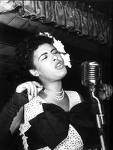 It’s fascinating to follow these guys through different bands. Both were really amazing musicians with a sense of swing that’s really incomparable. You can pick Armstrong’s trumpet in any recording, no matter how crappy and crackly. and Billie… her later stuff is really tricky to dance to because she’s so clever with phrasing and timing. Sometimes she’s so way, way back there behind the beat you’re sure she’s just about to be out of time completely. I like listening to the way she shapes a band when she’s singing with them – with live recordings. She can work around a straight, uptight band and make them sound like they’re actually hot. Same goes for Louis – these guys have a sense of timing that’s impeccable. Like really good comedians.
It’s fascinating to follow these guys through different bands. Both were really amazing musicians with a sense of swing that’s really incomparable. You can pick Armstrong’s trumpet in any recording, no matter how crappy and crackly. and Billie… her later stuff is really tricky to dance to because she’s so clever with phrasing and timing. Sometimes she’s so way, way back there behind the beat you’re sure she’s just about to be out of time completely. I like listening to the way she shapes a band when she’s singing with them – with live recordings. She can work around a straight, uptight band and make them sound like they’re actually hot. Same goes for Louis – these guys have a sense of timing that’s impeccable. Like really good comedians.